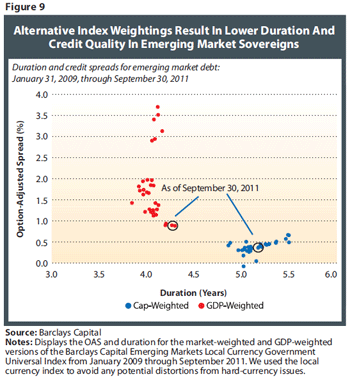An Investor’s Guide to Understanding Nontraditional ETFs
Post on: 8 Апрель, 2015 No Comment

An Investor’s Guide to Understanding Nontraditional ETFs
An Investor’s Guide to Understanding Nontraditional ETFs
If you have seen a Hollywood movie about Wall Street in the last twenty years, odds are you have at least heard the term, “ETFs”. In fact, you may even know what the letters stand for: Exchange-Traded Funds. But many investors cannot go beyond that, and the reason is perfectly understandable. ETFs, especially nontraditional ETFs, are rarely explained to investors and even more rarely understood by investors. Even worse, most stockbrokers who recommend them do not even fully understand how ETFs work.
This article will attempt to distill some of the enigma behind these often seen and frequently misunderstood investments.
ETFs Generally
To put it simply, an ETF, much like a mutual fund, is a bundle of stocks that seek to track the market or a sector within the market. Specifically, an ETF will pick a certain index known as a “benchmark” to track. Some ETF’s track commodities like oil, gold, or other metals. Ideally and most simplistically, if the price of gold goes up, an ETF with a gold benchmark should go up as well.
To further understand the effect of this, let’s look at an example, take Vanguard, the largest provider of ETFs in the country. Vanguard REIT ETF (VNQ) is an ETF that invests in stocks issued by real estate investment trusts (REITs). This ETF tracks the MSCI US REIT Index, which is a REIT index comprised of 143 stocks. As the price of the MSCI US REIT Index goes up, so too will the Vanguard REIT ETF. However, even Vanguard ranks this ETF as a 4 of 5 on the risk scale for investors, given the rapidly changing market.
Nontraditional ETFs
Now that we have laid the ground floor for a basic understanding of what ETF’s are, it is time to peel back the second layer of the onion and discuss the widely misunderstood topic of nontraditional ETFs.
Nontraditional ETFs generally can be divided into three categories, leveraged, inverse and leveraged and inverse. A leveraged ETF will seek to double or even triple the outcome of the index it is tracking in the market that day by using margin. For example, assume a benchmark index increases by 1%. A two times leveraged ETF would move up 2%. Adversely, an inverse ETF, which seeksto return the opposite of the performance of the benchmark would decrease by 1%. An inverse leveraged ETF uses leverage to track the inverse or opposite of a benchmark.
The crucial issue with nontraditional ETFs, and what most people misunderstand, is that most nontraditional ETF’s “reset” at the end of each day. This means that the securities that are held by the non-traditional ETF are constantly bought and sold. As a result, a phenomon called “tracking error” begins to develop. Tracking error means that over extended periods of time a nontraditional ETF may not exactly track an index. The longer an investor holds a nontraditional ETF the more pronounced the tracking error will be. Eventually, the purpose of holding a nontraditional ETF becomes frustrated because the returns do not accurately track the benchmark. For this reason, the Securities and Exchange Commission as well as FINRA warn investors that most non-traditional ETFs should only be held daily.
Nontraditional ETFs are more suitable for very experienced day traders who will be willing to monitor the investment hour by hour and sell at the end of the day. They are not likely suitable for inexperienced long-term investors.
Investor warning
Broker-dealer firms often lure investors into investing in nontraditional ETFs with the promise of diversification, low fees and low risk. Most brokers make the critical error of advising clients to hold nontraditional ETFs for extended periods of time, frustrating their purpose and creating an “investment strategy” that will fail.
Several firms have been fined by the Financial Industry Regulatory Authority (FINRA) in the recent past for recommending these nontraditional ETFs without proper supervisory oversight and/or due diligence.
For example, on December 29, 2014, broker-dealer firm, Feltl & Co. was fined $225,000 and ordered to pay over $13,000 in restitution to aggrieved customers who suffered financial losses as a result of Feltl & Co. brokers who recommended unsuitable nontraditional ETFs (Exchange-Traded Funds) .
In August, 2014, Infinex Investments, Inc. was fined $75,000 and ordered to pay $280,000 in restitution to customers who were recommended and sold ETFs that the Infinex brokers did not understand themselves. Not only did the Infinex customers hold unsuitable investments, but they also held onto the ETF’s for longer than was suggested in the ETFs prospectus, which cost them significantly.
In January 2013, Morgan Keegan, now a subsidiary of Raymond James, was censured and fined $365,000 for recommending and selling nontraditional ETFs to customers. Morgan Keegan was also ordered to pay over $480,000 in restitution to its customers.
If you have fallen victim to the ill explained and often confusing world of nontraditional ETFs at the recommendation of a broker-dealer firm, you may be entitled to recovery of your losses. Contact the law firm of Fitapelli Kurta today to speak directly to an attorney. Our consultations are always free and we would love to hear from you to further discuss the merits of your case.
Time to file your claim is limited, so do not wait. Call 212-658-1502 now for your free consultation.














